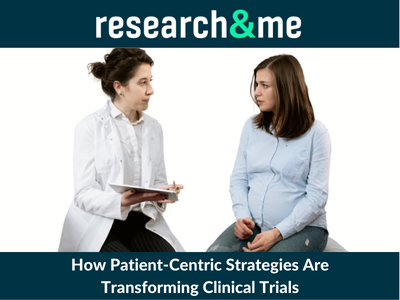January 25, 2023

Written By:
Rob C.
Patient centricity is a term on everyone’s lips right now, and with good reason. The life science sector is coming around to the idea that, by putting the needs of the patient at the heart of drug development, we can improve the patient experience and reduce development timelines while creating significant business value. Research bears this out. According to The Economist, 87% of patient-centric clinical trials have positive results, compared to just 68% of traditional trials.
There are both ethical and business incentives to adopt patient-centered strategies throughout the drug development process. But that’s not all. The FDA’s recent Patient-Focused Drug Development (PFDD) guidelines have made patient centricity a matter of regulatory necessity.
Enacted last summer, the FDA’s PFDD guidelines are “a systematic approach to help ensure that patients’ experiences, perspectives, needs, and priorities are captured and meaningfully incorporated into drug development and evaluation.” The guidelines have been split into four separate guidance documents:
Collecting Comprehensive and Representative Input: This first document is about accurately capturing patient experience data from a target population. Here, the FDA’s intention goes beyond the inclusion of a diverse, representative range of participants. Clinical teams must also ensure that mechanisms are in place to listen and respond to those participants. Digital tools make this increasingly possible. “Increasingly, patients’ experiential knowledge is being incorporated into clinical research—including in real-world studies—facilitated by the availability of technology.”
Methods to Identify what is Important to Patients: The second guidance document concerns the patient experience: understanding what they like about the trial process, what they don’t, and what clinical teams can do to make a difference. The FDA requires that teams have methods in place to capture these insights.
Selecting, Developing, or Modifying Fit-for-Purpose Clinical Outcomes Assessments: This third guidance document outlines how clinical outcome assessments should be used to develop actionable patient-centric strategies. The FDA encourages clinicians to think strategically about where, when, and how patient insights should be applied. Not everything identified as important by patients, caregivers, and clinicians can demonstrate change in a specific treatment trial.
Incorporating Clinical Outcome Assessments into Endpoints for Regulatory Decision Making: According to the FDA, the fourth guidance document addresses “methodologies, standards, and technologies that may be used for the collection, capture, storage, and analysis of COA data” and “address methods to better incorporate COAs into endpoints that are considered significantly robust for regulatory decision-making.”
These FDA guidance documents provide a framework for a patient-centric approach to drug development, but when it comes to putting theory into practice, organizations are largely left to their own devices.
The Benefits Of Patient Centricity
To many, the benefits of patient centricity are self-evident. And while enacting widespread change is never easy for life science organizations, the benefits of a patient-centric culture are impossible to deny.
Putting the needs of individuals at the heart of the drug development process reveals immediate benefits in terms of the patient experience. This has been proven in focus groups for patients experiencing menopause and perimenopause, where participants were uniquely able to share their emotional experiences of living with the condition with clinicians. Similarly, a roundtable discussion on presbyopia provided patient insights into how the condition affects quality of life, subjects’ openness to new therapies, and the need to move away from describing the condition as a “consequence of aging”. Capturing insights like these empowers clinical teams to treat trial participants like people, rather than patients.
“Patients are experts at living with their own disease and can partner in and co-create more effective and efficient therapies, aimed at what patients genuinely care about," write the editors of Pragmatic Randomized Clinical Trials.
Bringing the patient’s voice into protocol design right from the very beginning ensures that study objectives, endpoints, and all other critical milestones keep patient needs in mind. With the patient at the center of protocol design, inefficiencies become easier to spot, and development timelines can be reduced. Furthermore, including patient feedback in the creation of draft guidelines and informed consent forms means they can bring their lived experiences to the table—leading to the capture of valuable insights that can inform decision-making and reduce time to market.
As we know, the majority of clinical trials and research studies are destined to fail. In fact, as many as 90% of drugs fail to make it to market. The main reason trials fail is poor recruitment and retention, with dropout rates averaging around 30%, and an incredible 85% of clinical trials failing to meet their recruitment goals. By including the voice of the patient in protocol design, clinical teams can help minimize barriers to participation—improving trial recruitment rates—and enhancing the patient experience. Together these factors help reduce dropout rates. More participants completing a trial equates to more drugs potentially achieving FDA approval, and ultimately, making it to market.
How To Adopt A Culture Of Patient Centricity
The COVID-19 pandemic has shown us how patients and clinicians alike can benefit from digital technologies such as tele-health, with 9 of 10 patients saying their experience was as good as or better than pre-pandemic in-person care. Applied across the drug development lifecycle, similar technologies are helping clinical teams bring patient-centric cultures to their organizations.
Other technologies—such as artificial intelligence, network analytics, and natural language processing—are helping clinical teams better understand disease communities. These tools reveal the makeup of a disease community, show how HCPs, patients, and trial sites are connected, and reveal trends and sentiments across expert and patient groups. It’s easy to see how these insights can be applied in line with the PFDD guidance documents.
Life science companies can be understandably reluctant to embrace change. But patient-centric clinical trials are ultimately beneficial to both trial participants, and pharmaceutical and med device companies. Patient centricity is a win-win, and technology can help us get there.

January 23, 2023
Diversity in Clinical Trials: Why It’s Important, and How to Improve It The clinicians that structure a trial or study have to take a variety of factors into consideration. What are the parameters of...
Read More
January 24, 2023
What’s in it for Me? Clinical trials are part of clinical research and at the heart of all medical advances. They help scientists better understand health and disease, and help look at new ways to...
Read More
January 22, 2023
1. Clinical Trials Are The Backbone of Drug Development Have you ever thought closely about the contents of your medicine cabinet? The medicines inside may have different purposes, but they have...
Read More